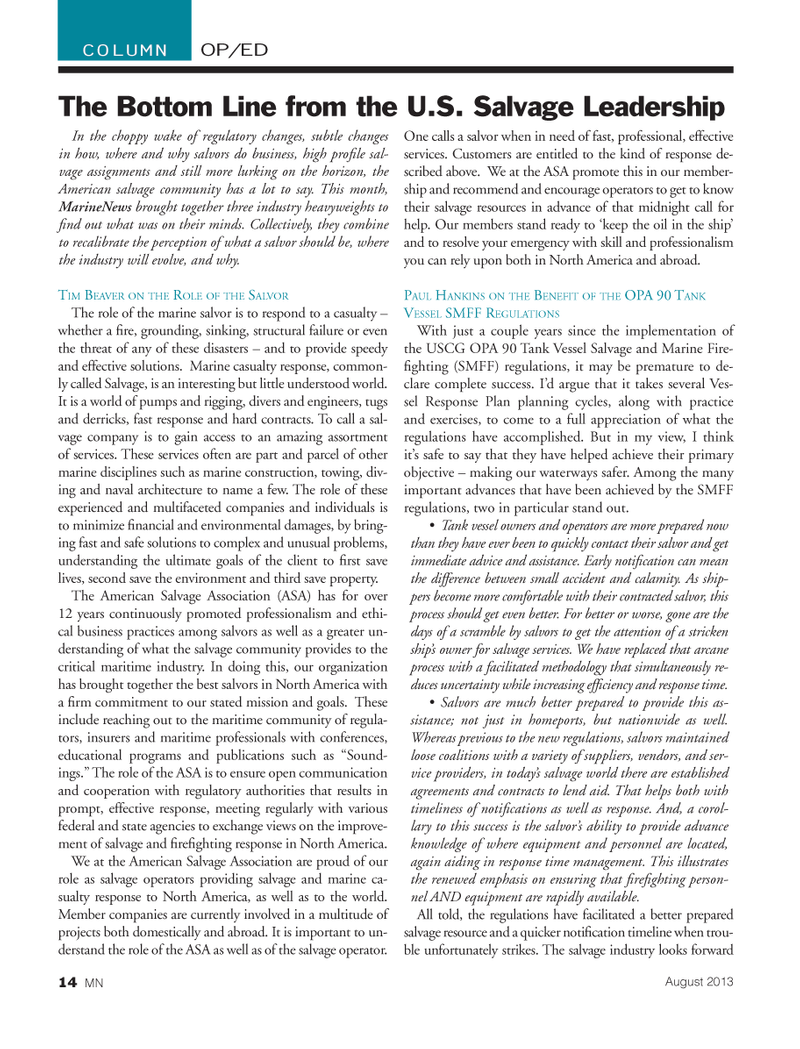
Page 14: of Marine News Magazine (August 2013)
Salvage & Response
Read this page in Pdf, Flash or Html5 edition of August 2013 Marine News Magazine
In the choppy wake of regulatory changes, subtle changes in how, where and why salvors do business, high pro? le sal- vage assignments and still more lurking on the horizon, the American salvage community has a lot to say. This month, MarineNews brought together three industry heavyweights to ? nd out what was on their minds. Collectively, they combine to recalibrate the perception of what a salvor should be, where the industry will evolve, and why. TIM BEAVER ON THE ROLE OF THE SALVOR The role of the marine salvor is to respond to a casualty ? whether a ? re, grounding, sinking, structural failure or even the threat of any of these disasters ? and to provide speedy and effective solutions. Marine casualty response, common- ly called Salvage, is an interesting but little understood world. It is a world of pumps and rigging, divers and engineers, tugs and derricks, fast response and hard contracts. To call a sal- vage company is to gain access to an amazing assortment of services. These services often are part and parcel of other marine disciplines such as marine construction, towing, div- ing and naval architecture to name a few. The role of these experienced and multifaceted companies and individuals is to minimize ? nancial and environmental damages, by bring- ing fast and safe solutions to complex and unusual problems, understanding the ultimate goals of the client to ? rst save lives, second save the environment and third save property. The American Salvage Association (ASA) has for over 12 years continuously promoted professionalism and ethi- cal business practices among salvors as well as a greater un- derstanding of what the salvage community provides to the critical maritime industry. In doing this, our organization has brought together the best salvors in North America with a ? rm commitment to our stated mission and goals. These include reaching out to the maritime community of regula- tors, insurers and maritime professionals with conferences, educational programs and publications such as Sound- ings.? The role of the ASA is to ensure open communication and cooperation with regulatory authorities that results in prompt, effective response, meeting regularly with various federal and state agencies to exchange views on the improve- ment of salvage and ? re? ghting response in North America. We at the American Salvage Association are proud of our role as salvage operators providing salvage and marine ca- sualty response to North America, as well as to the world. Member companies are currently involved in a multitude of projects both domestically and abroad. It is important to un- derstand the role of the ASA as well as of the salvage operator. One calls a salvor when in need of fast, professional, effective services. Customers are entitled to the kind of response de- scribed above. We at the ASA promote this in our member- ship and recommend and encourage operators to get to know their salvage resources in advance of that midnight call for help. Our members stand ready to keep the oil in the ship and to resolve your emergency with skill and professionalism you can rely upon both in North America and abroad. PAUL HANKINS ON THE BENEFIT OF THE OPA 90 T ANK VESSEL SMFF REGULATIONS With just a couple years since the implementation of the USCG OPA 90 Tank Vessel Salvage and Marine Fire- ? ghting (SMFF) regulations, it may be premature to de- clare complete success. Id argue that it takes several Ves- sel Response Plan planning cycles, along with practice and exercises, to come to a full appreciation of what the regulations have accomplished. But in my view, I think its safe to say that they have helped achieve their primary objective ? making our waterways safer. Among the many important advances that have been achieved by the SMFF regulations, two in particular stand out. ? Tank vessel owners and operators are more prepared now than they have ever been to quickly contact their salvor and get immediate advice and assistance. Early noti? cation can mean the difference between small accident and calamity. As ship- pers become more comfortable with their contracted salvor, this process should get even better. For better or worse, gone are the days of a scramble by salvors to get the attention of a stricken ships owner for salvage services. We have replaced that arcane process with a facilitated methodology that simultaneously re- duces uncertainty while increasing ef? ciency and response time. ? Salvors are much better prepared to provide this as- sistance; not just in homeports, but nationwide as well. Whereas previous to the new regulations, salvors maintained loose coalitions with a variety of suppliers, vendors, and ser- vice providers, in todays salvage world there are established agreements and contracts to lend aid. That helps both with timeliness of noti? cations as well as response. And, a corol- lary to this success is the salvors ability to provide advance knowledge of where equipment and personnel are located, again aiding in response time management. This illustrates the renewed emphasis on ensuring that ? re? ghting person- nel AND equipment are rapidly available. All told, the regulations have facilitated a better prepared salvage resource and a quicker noti? cation timeline when trou- ble unfortunately strikes. The salvage industry looks forward OP/EDCOLUMNThe Bottom Line from the U.S. Salvage Leadership 14 MNAugust 2013MN August2013 Layout 1-17.indd 147/23/2013 7:41:40 PM

 13
13

 15
15
